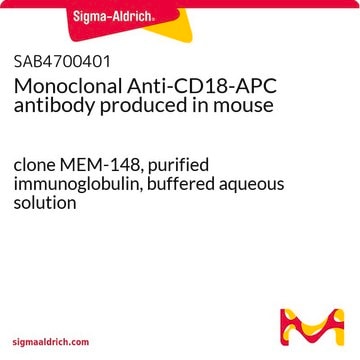LM1304
Avanti
17:0-14:1 PS
Avanti Research™ - A Croda Brand LM1304, methanol solution
Sinonimo/i:
1-heptadecanoyl-2-(9Z-tetradecenoyl)-sn-glycero-3-phospho-L-serine (ammonium salt)
About This Item
Prodotti consigliati
Forma fisica
methanol solution
Confezionamento
pkg of 1 × 1 mL (LM1304-1EA)
Produttore/marchio commerciale
Avanti Research™ - A Croda Brand LM1304
Concentrazione
~10 μg/mL (Refer to C of A for lot specific concentration. )
applicazioni
lipidomics
metabolomics
Condizioni di spedizione
dry ice
Temperatura di conservazione
−20°C
Stringa SMILE
[H][C@@](COP([O-])(OC[C@](C([O-])=O)([H])[NH3+])=O)(OC(CCCCCCC/C=C\CCCC)=O)COC(CCCCCCCCCCCCCCCC)=O.[NH4+]
Categorie correlate
Descrizione generale
Applicazioni
- for the detection of lipids by tandem mass spectrometry (MS/MS)
- to determine lipid concentration in human primary myotubes lipid extracts by mass spectrometry (MS) analysis
- for phospholipid quantification by MS
- for lipid extraction by methyl tert-butyl ether (MTBE) method
- for lipid quantification using liquid chromatography (LC)-MS
Azioni biochim/fisiol
Confezionamento
Note legali
Comunemente ordinati con questo prodotto
Avvertenze
Danger
Indicazioni di pericolo
Consigli di prudenza
Classi di pericolo
Acute Tox. 3 Dermal - Acute Tox. 3 Inhalation - Acute Tox. 3 Oral - Flam. Liq. 2 - STOT SE 1
Organi bersaglio
Eyes
Codice della classe di stoccaggio
3 - Flammable liquids
Classe di pericolosità dell'acqua (WGK)
WGK 2
Punto d’infiammabilità (°F)
49.5 °F - closed cup
Punto d’infiammabilità (°C)
9.7 °C - closed cup
Certificati d'analisi (COA)
Cerca il Certificati d'analisi (COA) digitando il numero di lotto/batch corrispondente. I numeri di lotto o di batch sono stampati sull'etichetta dei prodotti dopo la parola ‘Lotto’ o ‘Batch’.
Possiedi già questo prodotto?
I documenti relativi ai prodotti acquistati recentemente sono disponibili nell’Archivio dei documenti.
Il team dei nostri ricercatori vanta grande esperienza in tutte le aree della ricerca quali Life Science, scienza dei materiali, sintesi chimica, cromatografia, discipline analitiche, ecc..
Contatta l'Assistenza Tecnica.











